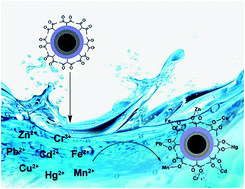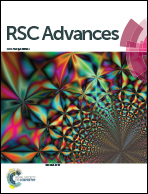Acetylacetone functionalized magnetic carbon microspheres for the highly-efficient adsorption of heavy metal ions from aqueous solutions
Abstract
Herein, Acac-C@Fe3O4, a magnetic carbon (C@Fe3O4) modified with acetylacetone (Acac), was first prepared and used as a solid-phase adsorbent for adsorbing some heavy metal ions from aqueous solution. The adsorbent was characterized by Fourier transform infrared spectroscopy (FTIR), X-ray diffraction (XRD), scanning electron microscopy (SEM), transmission electron microscopy (TEM), X-ray photoelectron spectroscopy (XPS), vibrating sample magnetometry (VSM) and BET studies. Some parameters affecting the adsorption and desorption processes were studied in Pb2+ solution, including sample pH, contact time, initial concentration, type and connection of the desorption solution. Absorption results showed that removal of Pb2+ was 100% under optimal conditions at an initial concentration of 10.0 mg L−1. The adsorption mechanism conformed well to a pseudo-second order kinetic model. The adsorption capacity of the sorbent also showed promising results with Hg2+, Cr3+, Fe2+, Cd2+, Mn2+, Zn2+, Cu2+ and Pb2+, where maximum adsorption capacities reached 98.0, 151.2, 188.9, 202.2, 286.3, 297.2, 305.1 and 345.3 mg g−1, respectively. The Acac-C@Fe3O4 microsphere material was successfully applied to the adsorption of heavy metal ions in aqueous solution.



 Please wait while we load your content...
Please wait while we load your content...